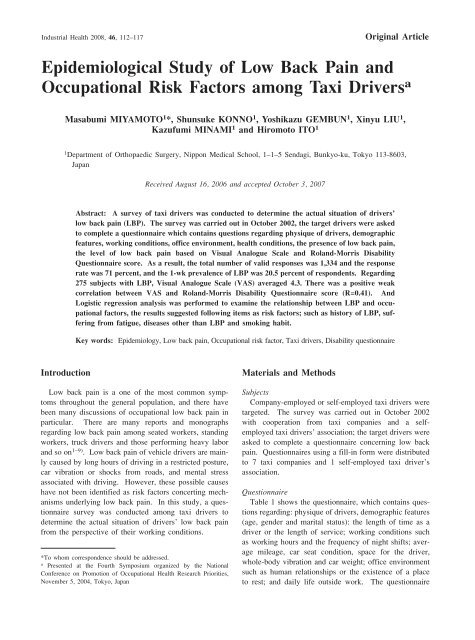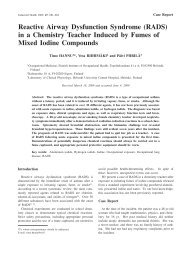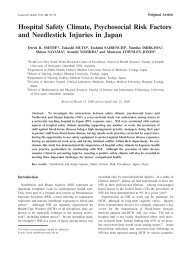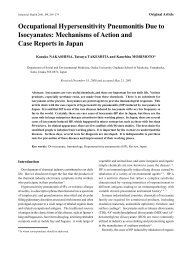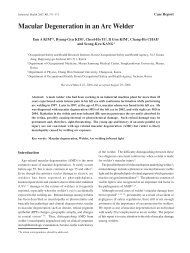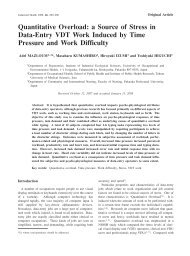Epidemiological Study of Low Back Pain and Occupational Risk ...
Epidemiological Study of Low Back Pain and Occupational Risk ...
Epidemiological Study of Low Back Pain and Occupational Risk ...
Create successful ePaper yourself
Turn your PDF publications into a flip-book with our unique Google optimized e-Paper software.
Industrial Health 2008, 46, 112–117<br />
Original Article<br />
<strong>Epidemiological</strong> <strong>Study</strong> <strong>of</strong> <strong>Low</strong> <strong>Back</strong> <strong>Pain</strong> <strong>and</strong><br />
<strong>Occupational</strong> <strong>Risk</strong> Factors among Taxi Drivers a<br />
Masabumi MIYAMOTO 1 *, Shunsuke KONNO 1 , Yoshikazu GEMBUN 1 , Xinyu LIU 1 ,<br />
Kazufumi MINAMI 1 <strong>and</strong> Hiromoto ITO 1<br />
1<br />
Department <strong>of</strong> Orthopaedic Surgery, Nippon Medical School, 1–1–5 Sendagi, Bunkyo-ku, Tokyo 113-8603,<br />
Japan<br />
Received August 16, 2006 <strong>and</strong> accepted October 3, 2007<br />
Abstract: A survey <strong>of</strong> taxi drivers was conducted to determine the actual situation <strong>of</strong> drivers’<br />
low back pain (LBP). The survey was carried out in October 2002, the target drivers were asked<br />
to complete a questionnaire which contains questions regarding physique <strong>of</strong> drivers, demographic<br />
features, working conditions, <strong>of</strong>fice environment, health conditions, the presence <strong>of</strong> low back pain,<br />
the level <strong>of</strong> low back pain based on Visual Analogue Scale <strong>and</strong> Rol<strong>and</strong>-Morris Disability<br />
Questionnaire score. As a result, the total number <strong>of</strong> valid responses was 1,334 <strong>and</strong> the response<br />
rate was 71 percent, <strong>and</strong> the 1-wk prevalence <strong>of</strong> LBP was 20.5 percent <strong>of</strong> respondents. Regarding<br />
275 subjects with LBP, Visual Analogue Scale (VAS) averaged 4.3. There was a positive weak<br />
correlation between VAS <strong>and</strong> Rol<strong>and</strong>-Morris Disability Questionnaire score (R=0.41). And<br />
Logistic regression analysis was performed to examine the relationship between LBP <strong>and</strong> occupational<br />
factors, the results suggested following items as risk factors; such as history <strong>of</strong> LBP, suffering<br />
from fatigue, diseases other than LBP <strong>and</strong> smoking habit.<br />
Key words: Epidemiology, <strong>Low</strong> back pain, <strong>Occupational</strong> risk factor, Taxi drivers, Disability questionnaire<br />
Introduction<br />
<strong>Low</strong> back pain is a one <strong>of</strong> the most common symptoms<br />
throughout the general population, <strong>and</strong> there have<br />
been many discussions <strong>of</strong> occupational low back pain in<br />
particular. There are many reports <strong>and</strong> monographs<br />
regarding low back pain among seated workers, st<strong>and</strong>ing<br />
workers, truck drivers <strong>and</strong> those performing heavy labor<br />
<strong>and</strong> so on 1–9) . <strong>Low</strong> back pain <strong>of</strong> vehicle drivers are mainly<br />
caused by long hours <strong>of</strong> driving in a restricted posture,<br />
car vibration or shocks from roads, <strong>and</strong> mental stress<br />
associated with driving. However, these possible causes<br />
have not been identified as risk factors concerting mechanisms<br />
underlying low back pain. In this study, a questionnaire<br />
survey was conducted among taxi drivers to<br />
determine the actual situation <strong>of</strong> drivers’ low back pain<br />
from the perspective <strong>of</strong> their working conditions.<br />
*To whom correspondence should be addressed.<br />
a<br />
Presented at the Fourth Symposium organized by the National<br />
Conference on Promotion <strong>of</strong> <strong>Occupational</strong> Health Research Priorities,<br />
November 5, 2004, Tokyo, Japan<br />
Materials <strong>and</strong> Methods<br />
Subjects<br />
Company-employed or self-employed taxi drivers were<br />
targeted. The survey was carried out in October 2002<br />
with cooperation from taxi companies <strong>and</strong> a selfemployed<br />
taxi drivers’ association; the target drivers were<br />
asked to complete a questionnaire concerning low back<br />
pain. Questionnaires using a fill-in form were distributed<br />
to 7 taxi companies <strong>and</strong> 1 self-employed taxi driver’s<br />
association.<br />
Questionnaire<br />
Table 1 shows the questionnaire, which contains questions<br />
regarding: physique <strong>of</strong> drivers, demographic features<br />
(age, gender <strong>and</strong> marital status): the length <strong>of</strong> time as a<br />
driver or the length <strong>of</strong> service; working conditions such<br />
as working hours <strong>and</strong> the frequency <strong>of</strong> night shifts; average<br />
mileage, car seat condition, space for the driver,<br />
whole-body vibration <strong>and</strong> car weight; <strong>of</strong>fice environment<br />
such as human relationships or the existence <strong>of</strong> a place<br />
to rest; <strong>and</strong> daily life outside work. The questionnaire
EPIDEMIOLOGICAL STUDY ON LOW BACK PAIN AMONG TAXI DRIVERS 113<br />
Table 1. Questions included in the questionnaire<br />
• Gender, age <strong>and</strong> physique <strong>of</strong> drivers<br />
• Length <strong>of</strong> service as a taxi driver<br />
• Working conditions such as working hours <strong>and</strong> night-shift frequency<br />
• Average mileage, car seat space <strong>and</strong> condition, whole-body vibration<br />
<strong>and</strong> car weight<br />
• Office environment such as human relationships or the existence <strong>of</strong><br />
a place to rest<br />
• Daily life outside work such as sleep, habit <strong>of</strong> smoking or exercise<br />
• Health conditions such as diseases other than low back pain<br />
• Existence <strong>of</strong> low back pain, VAS <strong>and</strong> Rol<strong>and</strong>-Morris Questionnaire<br />
score<br />
• History <strong>of</strong> diseases causing low back pain<br />
also included questions regarding: health conditions such<br />
as diseases other than low back pain; history <strong>of</strong> treatment<br />
<strong>and</strong> sick-leave due to low back pain <strong>and</strong>; the presence <strong>of</strong><br />
low back pain in the past one week. We defined the incidence<br />
rate <strong>of</strong> subjects who experienced LBP (low back<br />
pain) in the past one week as the prevalence <strong>of</strong> the LBP;<br />
the level <strong>of</strong> low back pain based on Visual Analogue<br />
Scale (the levels <strong>of</strong> LBP/VAS) <strong>and</strong>; Rol<strong>and</strong>-Morris<br />
Disability Questionnaire score to assess physical disability<br />
due to low back pain (the disability level <strong>of</strong><br />
ADL/RMDQ score) 1) .<br />
Statistical analysis<br />
The questionnaire results were used to conduct the following<br />
analyses: the prevalence <strong>of</strong> LBP <strong>and</strong> the correlation<br />
between the levels <strong>of</strong> LBP <strong>and</strong> the disability level <strong>of</strong><br />
ADL (activities <strong>of</strong> daily living): the relationship between<br />
the LBP incidence <strong>and</strong> occupational factors. For the latter<br />
analyses, we compared the subjects with LBP from<br />
those without LBP by Mann-Whitney test for numerical<br />
data or by χ-square test for categorical data. Furthermore,<br />
to identify LBP-related occupational factors, we used multiple<br />
logistic regression <strong>and</strong> obtained estimates <strong>of</strong> the<br />
prevalence odds ratio (POR).<br />
The responses from respondents with a history <strong>of</strong> diseases<br />
causing low back pain were excluded at the time <strong>of</strong><br />
analysis in order to focus simply on the low back pain<br />
that was associated with work as drivers.<br />
All these statistical analyses were carried out by SPSS<br />
10.0 statistical s<strong>of</strong>tware, <strong>and</strong> significance was accepted at<br />
the 5 % level.<br />
Results<br />
The prevalence <strong>of</strong> LBP<br />
The total number <strong>of</strong> valid responses was 1,334 <strong>and</strong> the<br />
percentage <strong>of</strong> participation was 71 percent. The fundamental<br />
attributes <strong>of</strong> the investigated subjects are presented<br />
in Table 2. The average age <strong>of</strong> respondents was 51.5<br />
Table 2. Work conditions <strong>and</strong> the characteristics <strong>of</strong> the subjects<br />
(n=1,344)<br />
Mean Min Max SD<br />
Age (yr) 51.5 24 79 9.5<br />
Height (cm) 167.1 146 185 6.1<br />
Weight (kg) 66.1 42 100 9.8<br />
BMI (kg/m 2 ) 23.7 16.0 37.2 3.0<br />
The length <strong>of</strong> service 14.1 0 52.0 12.1<br />
Daily working hours 12.3 1.0 24.0 5.2<br />
Monthly mileage 3,416.4 200 11,800 1,115.7<br />
yr old <strong>and</strong> the average length <strong>of</strong> service was 14.1 yr. The<br />
prevalence <strong>of</strong> LBP was 20.5 percent <strong>of</strong> respondents.<br />
The levels <strong>of</strong> LBP <strong>and</strong> the disability <strong>of</strong> ADL<br />
Regarding 275 subjects with LBP, the level <strong>of</strong><br />
LBP/VAS averaged 4.3. The response rate <strong>of</strong> each item<br />
in RMDQ is presented in Table 3. High positive responses<br />
were found in the following questions; I change position<br />
frequently to try to get my back comfortable; I avoid<br />
heavy jobs around the house because <strong>of</strong> my back; Because<br />
<strong>of</strong> my back, I lie down to rest more <strong>of</strong>ten; <strong>and</strong> the RMDQ<br />
score averaged 3.5. Figure 1 shows the relation between<br />
the level <strong>of</strong> LBP <strong>and</strong> the RMDQ score. There was a positive<br />
weak correlation between the two, <strong>and</strong> the correlation<br />
coefficient was 0.41.<br />
Comparison between the subjects with LBP (LBP group)<br />
<strong>and</strong> without LBP (without LBP group)<br />
Concerning items in the questionnaire showing significant<br />
differences between the groups with <strong>and</strong> without<br />
LBP by χ-square test, the highest odds ratio was 5.35 for<br />
the question; “I had a history <strong>of</strong> low back pain before<br />
working as a driver”; the next highest odds ratio was 2.77<br />
on the question “I seldom feel energetic”; <strong>and</strong> the next<br />
was 2.60 for two questions: “I suffer from diseases other<br />
than low back pain” <strong>and</strong> “I do not have enough time to<br />
relax at home”, 2.21 for “I do not sleep well”, 1.93 for<br />
“narrow space for drivers”, <strong>and</strong> “feel strong car vibration”<br />
had an odds ratio <strong>of</strong> 1.90 (Table 4).<br />
However, there were no differences between variables<br />
from those either with or without LBP concerning following<br />
questions such as age, gender, height, weight <strong>and</strong><br />
BMI, the length <strong>of</strong> service, daily working hours, monthly<br />
mileage <strong>and</strong> frequency <strong>of</strong> night-shift work (Table 5).<br />
The result <strong>of</strong> the multiple logistic regression analysis <strong>and</strong><br />
prevalence odds ratio (POR)<br />
Logistic regression analysis using the existence or<br />
nonexistence <strong>of</strong> low back pain as a dependent variable<br />
was performed. Table 6 shows that responses to four<br />
items were significant: 1) I had a history <strong>of</strong> low back pain
114 M MIYAMOTO et al.<br />
Table 3. The response rates among respondents with LBP by Rol<strong>and</strong>-Morris Disability<br />
Questionnaire (n=190)<br />
%<br />
I stay at home most <strong>of</strong> the time because <strong>of</strong> my back. 11.3<br />
I change position frequently to try <strong>and</strong> get my back comfortable. 69.2<br />
I walk more slowly than usual because <strong>of</strong> my back. 12.7<br />
Because <strong>of</strong> my back I am not doing any <strong>of</strong> the jobs that I usually do around the house. 3.6<br />
Because <strong>of</strong> my back, I use a h<strong>and</strong>rail to get upstairs. 5.9<br />
Because <strong>of</strong> my back, I lie down to rest more <strong>of</strong>ten. 41.6<br />
Because <strong>of</strong> my back, I have to hold on to something to get out <strong>of</strong> an easy chair. 6.3<br />
Because <strong>of</strong> my back, I try to get other people to do things for me. 0.9<br />
I get dressed more slowly then usual because <strong>of</strong> my back. 3.5<br />
I only st<strong>and</strong> for short periods <strong>of</strong> time because <strong>of</strong> my back. 22.6<br />
Because <strong>of</strong> my back, I try not to bend or kneel down. 22.6<br />
I find it difficult to get out <strong>of</strong> a chair because <strong>of</strong> my back. 4.1<br />
My back is painful almost all the time. 20.4<br />
I find it difficult to turn over in bed because <strong>of</strong> my back. 5.9<br />
My appetite is not very good because <strong>of</strong> my back pain. 1.8<br />
I have trouble putting on my socks (or stockings) because <strong>of</strong> the pain in my back. 10.9<br />
I only walk short distances because <strong>of</strong> my back. 16.7<br />
I sleep less well on my back. 13.1<br />
Because <strong>of</strong> my back pain, I get dressed with help from someone else. 0.5<br />
I sit down for most <strong>of</strong> the day because <strong>of</strong> my back. 11.3<br />
I avoid heavy jobs around the house because <strong>of</strong> my back. 48.0<br />
Because <strong>of</strong> my back pain, I am more irritable <strong>and</strong> bad tempered with people than usual. 5.4<br />
Because <strong>of</strong> my back, I go upstairs more slowly than usual. 14.9<br />
I stay in bed most <strong>of</strong> the time because <strong>of</strong> my back. 4.1<br />
before working as a driver, 2) I suffer from fatigue, 3) I<br />
have diseases other than low back pain, <strong>and</strong> 4) I have a<br />
habit <strong>of</strong> smoking.<br />
Discussion<br />
Many researchers have already reported the high risk<br />
for LBP <strong>and</strong> various spinal disorders among pr<strong>of</strong>essional<br />
drivers <strong>of</strong> vehicles, such as bus, truck, tractor <strong>and</strong> so<br />
on 2–6) . It is thought that specific factors related to vehicle<br />
driving <strong>and</strong> work environments might influence the<br />
occurrence <strong>of</strong> LBP. Though there have been only several<br />
reports regarding taxi drivers, a significantly elevated<br />
1-yr prevalence <strong>of</strong> LBP (51%) was reported in Taipei taxi<br />
drivers 7) , <strong>and</strong> rate <strong>of</strong> 59% for men <strong>and</strong> 66% for women<br />
were reported in Norway 8) . In investigations <strong>of</strong> Japanese<br />
taxi drivers, the 1-yr prevalence <strong>of</strong> LBP was 45.8%, which<br />
was slightly lower than the values reported from other<br />
countries 9) .<br />
In our survey, we surveyed the 1-wk prevalence <strong>of</strong><br />
LBP, which was 20.5%. We adopted the prevalence <strong>of</strong><br />
LBP during the previous week in this study because the<br />
period <strong>of</strong> 1 yr was considered too long for subjects to<br />
remember accurately, <strong>and</strong> RMDQ also asks about the pre-<br />
Fig. 1. The relationship between the level <strong>of</strong> LBP <strong>and</strong> RMDQ<br />
score (n=190).<br />
There is a positive weak correlation between VAS <strong>and</strong> Rol<strong>and</strong>-Morris<br />
Disability score, <strong>and</strong> the correlation coefficient was 0.41.<br />
Industrial Health 2008, 46, 112–117
EPIDEMIOLOGICAL STUDY ON LOW BACK PAIN AMONG TAXI DRIVERS 115<br />
Table 4. The comparison between the groups with <strong>and</strong> without LBP tested<br />
by χ-square test<br />
Odd Ratio 95%C.I. p<br />
I had a history <strong>of</strong> low back pain before working as a driver<br />
5.35 3.87–7.37
116 M MIYAMOTO et al.<br />
vious one week.<br />
Regarding LBP-related occupational factors, multiple<br />
logistic regression analysis using all question items as<br />
evaluate variables was performed in stepwise method <strong>and</strong><br />
we obtained estimates <strong>of</strong> the prevalence odds ratio. It<br />
was suggested that certain factors were related to low<br />
back pain. As factors related to work details, narrow<br />
space for drivers <strong>and</strong> whole-body vibration were suggested.<br />
The relatively confined space within taxicabs may put<br />
taxi drivers at great risk for LBP, as biomechanical studies<br />
have shown that driving activities within automobiles<br />
can impose postural strain on lumbar spines 10) .<br />
However, various studies have already reported that<br />
whole-body vibration might be one <strong>of</strong> the causes <strong>of</strong> low<br />
back pain among various types <strong>of</strong> occupational drivers.<br />
In 1982, Wilder et al. identified that 3 frequencies cause<br />
the spine to resonate <strong>and</strong> that the greatest transmissibility<br />
<strong>of</strong> vibratory input occurs at the first resonant frequency<br />
<strong>of</strong> 5 Hz 11) .<br />
Bovenzi reported that bus driving is associated with<br />
an increased risk for low back problems that may be due<br />
to both whole-body vibration exposure <strong>and</strong> prolonged sitting<br />
in a constrained posture, <strong>and</strong> the average vertical<br />
whole-body vibration magnitude measured on the seat pan<br />
<strong>of</strong> buses was 0.4 m/s 22) . Chen has recently documented<br />
that urban taxi drivers are regularly exposed to lower levels<br />
<strong>of</strong> whole-body vibration (with a mean vertical vibration<br />
0.31 m/s 2 ) 12) .<br />
Harrison reported a thesis proposing the optimal seat<br />
to reduce the prevalence <strong>of</strong> LBP, which would be seat<br />
with shock absorbers to dampen whole-body vibration <strong>of</strong><br />
frequencies in the 1 to 20 Hz range, with a seat back, seat<br />
bottom, lumbar support, arm rests <strong>and</strong> head restraint that<br />
are adjustable to the individual needs <strong>of</strong> drivers 13) .<br />
Based on the findings <strong>of</strong> this survey, there are certain<br />
work environment factors suggested to be related to LBP,<br />
such as prolonged driving time <strong>and</strong> mental stress <strong>and</strong> so<br />
on. Regarding the length <strong>of</strong> working time, Chen reported<br />
that taxi drivers have OR <strong>of</strong> 1.79 for 1-yr prevalence<br />
<strong>of</strong> LBP when driving more than 4 h a day 7) . Pietri et al.<br />
reported that drivers have OR <strong>of</strong> 2.0 for LBP when driving<br />
more than 20 h a week 14) . Porter <strong>and</strong> Gyi also found<br />
that driving more than 20 h a week for work was associated<br />
with a high frequency <strong>of</strong> low back problems <strong>and</strong><br />
related sickness absence 15) . In this study, almost all drivers<br />
drove more than 40 h a week.<br />
It was suggested that mental stress might be related to<br />
LBP based on the significantly different response rates<br />
between respondents with or without LBP for the items:<br />
“I feel mental stress from customers”; “My work is not<br />
challenging.” Chen reported that mental factors were significantly<br />
associated with higher LBP prevalence, especially<br />
for drivers who felt moderate-to-severe job stress,<br />
the crude POR was 2.19 (CI 1.57–3.04), <strong>and</strong> who reported<br />
a high degree <strong>of</strong> job dissatisfaction, the crude POR<br />
was 1.48 (CI 1.11–1.96) 7) . Funakoshi pointed out the<br />
relation between work stress <strong>and</strong> low back pain in his<br />
research on taxi drivers, for drivers who work long hours,<br />
the age adjusted odds ratio was 2.19 (CI 0.98–5.16) 9) .<br />
Bongers reviewed the relationship between psychosocial<br />
work factors <strong>and</strong> musculoskeletal disease, <strong>and</strong> concluded<br />
that monotonous work, high perceived work load, time<br />
pressure, low control on the job <strong>and</strong> lack <strong>of</strong> social support<br />
by colleagues are related to or positively associated<br />
with musculoskeletal disease including LBP.<br />
Based on the results <strong>of</strong> this survey some other points<br />
were suggested to be related with LBP; prior health conditions<br />
such as having a history <strong>of</strong> LBP before working<br />
as a driver or suffering from diseases other than LBP;<br />
poor life style issues such as fatigue, insomnia, lack <strong>of</strong><br />
time to relax at home, habitual smoking or lack <strong>of</strong> physical<br />
exercise.<br />
Therefore possible measures for the prevention <strong>of</strong> low<br />
back pain are thought to include: counseling for psychological<br />
problems; implementation <strong>of</strong> medical examinations<br />
<strong>and</strong> guidance for consulting medical institutions;<br />
promotion <strong>of</strong> a better lifestyle; improvement <strong>of</strong> car structures,<br />
such as the improvement <strong>of</strong> car seat comfort <strong>and</strong><br />
the absorption <strong>of</strong> vibration; check for low back pain<br />
through medical examination prior to working as a driver,<br />
guidance for drivers with a previous history <strong>of</strong> low<br />
back pain, the provision <strong>of</strong> medical examination <strong>and</strong> necessary<br />
guidance for those who have already started working<br />
as drivers.<br />
Conclusions<br />
A survey <strong>of</strong> taxi drivers was conducted to determine<br />
the actual situation <strong>of</strong> drivers’ low back pain, <strong>and</strong> the 1-<br />
wk prevalence <strong>of</strong> LBP was 20.5 percent <strong>of</strong> respondents.<br />
For the prevention <strong>of</strong> low back pain, the following measures<br />
might be suggested: improvement <strong>of</strong> car seat comfort,<br />
treatment for coexisting diseases other than low back<br />
pain, psychological counseling, guidance for a better<br />
lifestyle, a check for previous history <strong>of</strong> low back pain<br />
prior to working as a driver, <strong>and</strong> appropriate guidance.<br />
Acknowledgements<br />
This survey was carried out based on Grant-in-aid for<br />
Scientific Research from the Ministry <strong>of</strong> Health, Labour<br />
<strong>and</strong> Welfare. I would like to take this opportunity to<br />
extend a deep gratitude to all participants.<br />
Industrial Health 2008, 46, 112–117
EPIDEMIOLOGICAL STUDY ON LOW BACK PAIN AMONG TAXI DRIVERS 117<br />
References<br />
1) Rol<strong>and</strong> M, Morris R (1983) A <strong>Study</strong> <strong>of</strong> the Natural<br />
History <strong>of</strong> <strong>Back</strong> pain Part I: Development <strong>of</strong> a Reliable<br />
<strong>and</strong> Sensitive Measure <strong>of</strong> Disability in <strong>Low</strong> <strong>Back</strong>. Spine<br />
8, 141–4.<br />
2) Bovenzi M, Z<strong>and</strong>ini A (1992) Self-related low back<br />
symptoms in urban bus drivers exposed to whole-body<br />
vibration <strong>and</strong> postural stress. Spine 17, 1048–59.<br />
3) Netterstrom B, Juel K (1989) <strong>Low</strong> back trouble among<br />
urban bus drivers in Denmark. Sc<strong>and</strong> J Soc Med 17,<br />
203–6.<br />
4) Piazzi A, Bollino G, Mattioli S (1991) spinal pathology<br />
in self-employed truck drivers. Med Lav 82, 122–30.<br />
5) Miyamoto M, Shirai Y, Nakayama Y, Gembun Y,<br />
Kaneda K (2000) An epidemiologic study <strong>of</strong> occupational<br />
low back pain in truck drivers. J Nippon Med Sch<br />
67, 186–90.<br />
6) Boshuzen HC, Bongers PM, Hulsh<strong>of</strong> CT (1990) Selfreported<br />
back pain in tractor drivers exposed to wholebody<br />
vibration. Int Arch Occup Environ Health 62,<br />
109–15.<br />
7) Chen JC, Chang WR, Chang W, Christiani D (2005)<br />
<strong>Occupational</strong> factors associated with low back pain in<br />
urban taxi drivers. Occup Med 55, 535–40.<br />
8) Anderson D, Raanaas R (2000) Psychosocial <strong>and</strong> physical<br />
factors <strong>and</strong> musculoskeletal illness in taxi drivers.<br />
In McCabe PT, Hanson MA, Robertson SA, (Eds.)<br />
Contemporary Ergonomics 2000, 322–7, Taylor &<br />
Francis, London.<br />
9) Funakoshi M, Tamura A, Taoda K, Tsujimura H,<br />
Nishiyama K (2003) <strong>Risk</strong> factor for low back pain<br />
among taxi drivers in Japan. Sangyo Eiseigaku Zasshi<br />
45, 235–47 (in Japanese).<br />
10) Harrison DD, Harrison SO, Cr<strong>of</strong>t AC, Harrison DE,<br />
Troyanovich SJ (1999) Sitting biomechanics part I:<br />
review <strong>of</strong> the literature. J Manipulative Physiol Ther 22,<br />
594–609.<br />
11) Wilder DG, Woodworth BB, Frymoyer JW, Pope MH<br />
(1982) Vibration <strong>and</strong> the human spine. Spine 7, 243–54.<br />
12) Chen JC, Chang WR, Shih TS, Chen CJ, Chang WP,<br />
Dennerlin JT, Ryan LM, Christiani DC (2004) Using<br />
exposure prediction rules for exposure assessment: an<br />
example on whole-body vibration in taxi drivers.<br />
Epidemiology 15, 293–9.<br />
13) Harrison DD, Harrison SO, Cr<strong>of</strong>t AC, Harrison DE,<br />
Troyanovich SJ (2000) Sitting Biomechanics, Part II:<br />
Optimal car driver’s seat <strong>and</strong> optimal driver’s spinal<br />
model. J Manipulative Physiol Ther 23, 37–47.<br />
14) Pietri F, Leclerc A, Boitel L, Chastang JF, Morcet JF,<br />
Blondet M (1992) <strong>Low</strong>-back pain in commercial travelers.<br />
Sc<strong>and</strong> J Work Environ Health 18, 52–8.<br />
15) Porter JM, Gyi DE (2002) The prevalence <strong>of</strong> musculoskeletal<br />
troubles among car drivers. Occup Med<br />
(Lond)52, 4–12.<br />
16) Bonger PM, de Winter CR, Kompier MA, Hildebr<strong>and</strong>t<br />
VH (1993) Psychosocial factors at work <strong>and</strong> musculoskeletal<br />
disease. Sc<strong>and</strong> J Work Environ Health 19,<br />
297–312.


